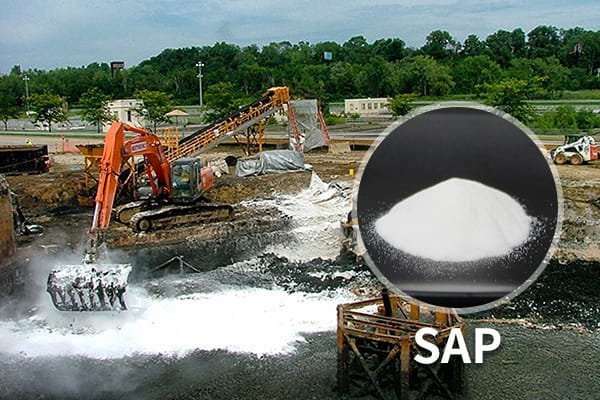Obtenga muestra gratuita
La tecnología de polímeros superabsorbentes (SAP) se utiliza en diversos mercados industriales, de consumo y profesionales. Muchos consumidores se encuentran con los SAP a diario, pero a menudo desconocen su presencia. Los SAP se encuentran comúnmente en aplicaciones como almohadillas absorbentes en envases de alimentos, compresas de gel frío/calor, fluidos de perforación y arena para gatos. Además, se emplean para solidificar líquidos generados durante procedimientos médicos, convirtiéndolos en residuos que no se clasifican como "bolsas rojas". Más allá de los productos de consumo y las aplicaciones médicas, los SAP también son compatibles con una gran variedad de materiales de desecho de procesos industriales y de construcción.

Recortes de perforación, fluidos usados y escombros de perforación direccional horizontal (HDD):
El polímero de savia puede mezclarse con los recortes de perforación y los fluidos usados para solidificarlos, lo que mejora la seguridad y la facilidad de gestión durante su eliminación.
También ayuda a contener y estabilizar los escombros generados durante las operaciones de HDD, mitigando así el impacto ambiental.
- Coal Combustion Residuals (Coal Fly Ash and Bottom Ash):
When added to coal fly ash and bottom ash, sap super absorbent polymer bind and solidify these materials, reducing leaching and facilitating disposal handling.
- Wastewater Treatment Sludge and Biosolids:
The integration of biodegradable superabsorbent polymer into wastewater treatment sludge and biosolids aids in dewatering, resulting in solid blocks or cakes that are easier to transport and dispose of.
- Water Treatment Sludge (e.g., Alum Sludge):
highly absorbent polymer can solidify alum sludge and similar water treatment residues, promoting safe handling and disposal.
- Flue Gas Desulphurization Waste:
They are used to solidify and stabilize flue gas desulphurization waste, preventing leaching and enhancing containment.
- Oil and Gas Drilling Fluids and Cuttings:
SAPs effectively solidify oil and gas drilling fluids and cuttings, diminishing their mobility and environmental impact.
When mixed with mine tailings, SAPs form stable, solid blocks that minimize the risk of contamination and erosion.
- Dredged Sediments:
sap absorbent facilitate the solidification of dredged sediments, reducing water content and improving their stability for disposal or reuse.
- Petroleum Tank Bottom Sludge:
They can solidify petroleum tank bottom sludge, reducing its volume and aiding in safe disposal.
- Retention Pond Muck:

The incorporation of SAPs into retention pond muck solidifies the material, simplifying handling and disposal.
- Saturated or Wet Soil:
Applied to saturated or wet soil, SAPs absorb excess moisture and stabilize the soil, making it more workable.
- Sandblast Media:
SAPs solidify used sandblast media, reducing dust and improving disposal handling.
- Paint Rinsate:
The addition of SAPs to paint rinsate solidifies the liquid waste, simplifying its management and proper disposal.
- Remediation Site Waste:
sap absorbent polymer assist in solidifying various wastes generated during site remediation, enhancing containment and lessening environmental impact.
- Highway Grinding Waste:
When incorporated into highway grinding waste, SAPs solidify the material, facilitating safer and easier handling and disposal.
- Combined Industrial Liquid Waste Streams:
SAPs solidify and encapsulate combined industrial liquid waste streams, improving containment and promoting proper disposal practices.
1. SAPs are distinguished as the swiftest, simplest, safest, and most cost-effective solution for managing liquid waste. They rapidly solidify a broad spectrum of waste fluids, significantly reducing processing time.
No specialized equipment is necessary for utilizing SAPs. Common machinery such as excavators, backhoes, or skid steers can effectively mix SAPs with waste fluids.
2. sap super absorbent are touch-safe, eliminating the need for specific Personal Protective Equipment (PPE), and they prevent hazardous liquid waste contaminants from leaching into landfills and the environment.
With the highest absorbency among available technologies, SAPs can absorb considerable liquid volumes with minimal quantities. Typically, SAPs are applied at dosage rates ranging from 0.5% to 1.5% by weight, a stark contrast to traditional absorbents like sawdust, which may necessitate dosage rates of up to 200%. This low-dosage characteristic is pivotal in reducing transportation and disposal costs, as it directly impacts the weight of the reagents transported and disposed of with the waste.
SAP Scenes represents an advanced technology or framework within the SAP ecosystem that focuses on creating immersive, interactive, and visually engaging digital twins or simulations of real-world scenarios. SAP absorption, or superabsorbent polymer absorption, refers to the process by which SAPs (superabsorbent polymers) rapidly take in and retain large volumes of liquid, usually water or aqueous solutions.
sap superabsorbent polymer is a highly efficient material that can absorb and retain hundreds of times its own weight in water, making it ideal for applications such as diaper manufacturing, agriculture water retention, and flood control measures, where rapid water absorption and retention are crucial. Superabsorbent polymers have a wide range of applications across various industries.
As a producer specializing in polymer superabsorbent materials, SOCO® offers tailored polymer solutions designed to meet the unique requirements of customers across a variety of applications and environments.
Contamos con un servicio en línea de "Preguntas al Experto" disponible las 24 horas. Si tiene alguna pregunta, contáctenos.